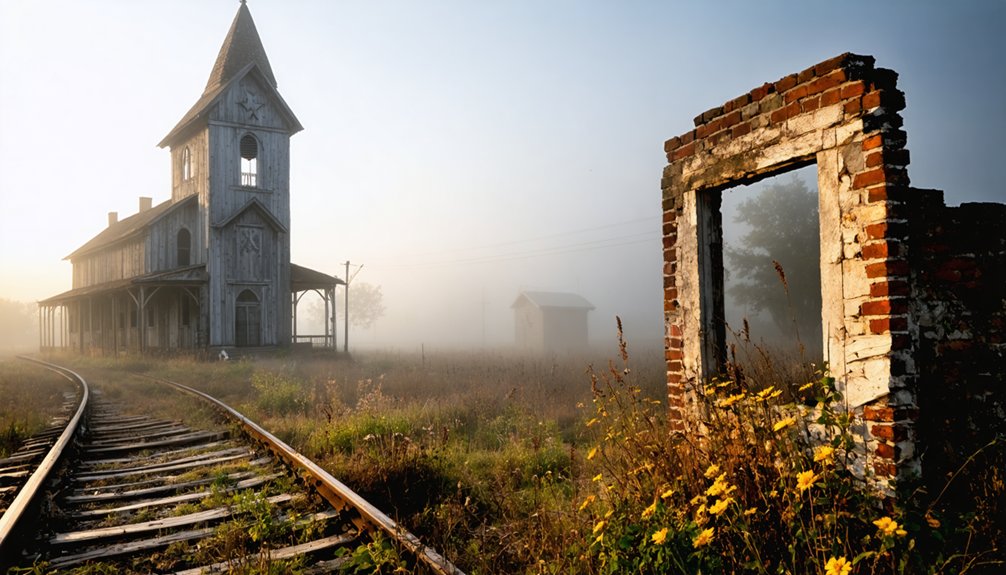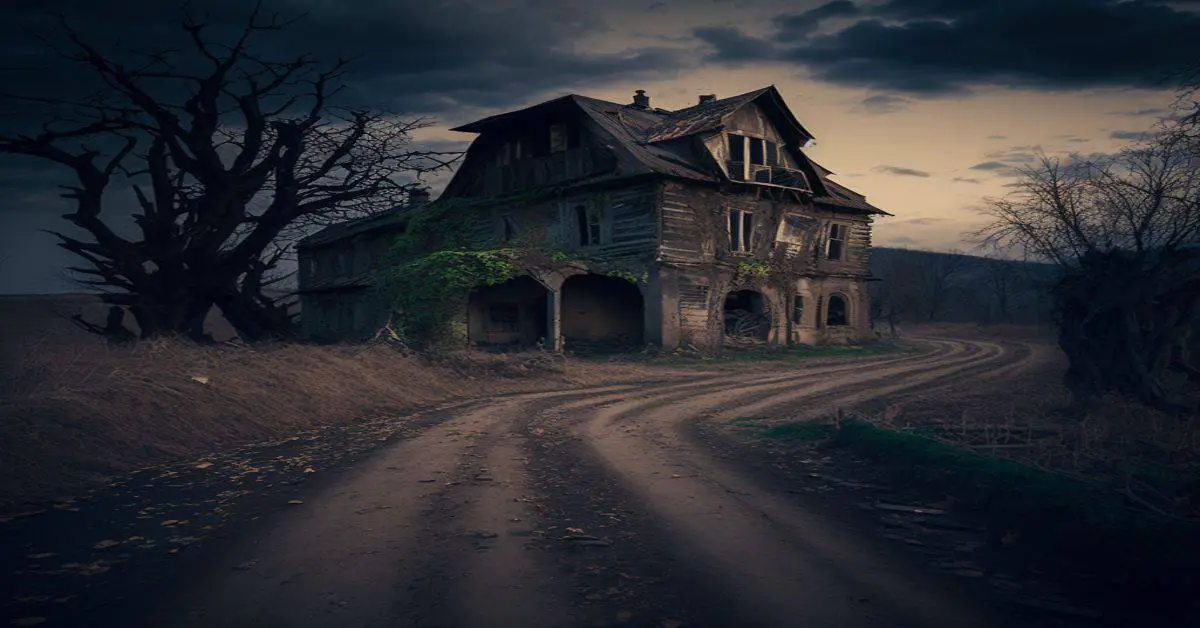You’ll find the ghost town of Shasta along the Mississippi River in Alexander County, Illinois, where it once thrived as a bustling agricultural and trading settlement. The town’s position in fertile floodplains initially supported farming and river commerce, but repeated flooding in the mid-1900s forced residents to abandon their homes and businesses. While little remains of the original settlement today, Shasta’s story reveals important lessons about the challenging relationship between river communities and nature’s powerful forces.
Key Takeaways
- Shasta was a Mississippi River trading settlement in Alexander County, Illinois that succumbed to repeated flooding and environmental challenges.
- The town’s location at 37°07′54″N and 89°23′42″W made it vulnerable to devastating floods, with waters reaching fifteen feet high in 1937.
- Early settlers built homes and businesses around river trade, but environmental pressures and flooding ultimately forced residents to abandon the settlement.
- Coal operations near Shasta contributed to environmental degradation through toxic contamination of groundwater and soil.
- The former townsite has been reclaimed by agricultural land, with only historical records and oral histories preserving its memory.
The Rise and Fall Along the Mississippi
While many ghost towns dot the landscape of Illinois, Shasta’s story stands as a tribute to life along the mighty Mississippi River.
You’ll find its historical narratives deeply intertwined with the river’s powerful influence, shaping both its rise and eventual abandonment.
Like other riverside settlements, Shasta’s fortunes rose and fell with the Mississippi’s waters. The river brought prosperity through trade and agriculture, but it also brought destruction. Similar to Cairo’s legacy, the area once thrived as a bustling trade hub before its population declined.
Researchers consulting Wikipedia disambiguation pages help differentiate this Shasta from other locations sharing the same name.
Economic fluctuations were common as flooding repeatedly threatened the town’s existence. You can trace Shasta’s decline through a familiar pattern seen in many river towns – the gradual exodus of residents seeking safer ground and better opportunities.
The settlement’s ultimate abandonment reflects the harsh realities of life along the Mississippi, where nature’s power often trumped human ambition.
Location and Geographic Features
You’ll find Shasta’s remains in a classic river valley setting along the Mississippi, where the former settlement sat at coordinates 37°07′54″N and 89°23′42″W in Alexander County’s fertile bottomlands.
Like nearby Illinois Central Railroad towns that flourished in the 1850s, Shasta developed as a minor shipping point along the river. The community’s position in the floodplain made it particularly vulnerable to the Mississippi’s seasonal floods, with the low-lying terrain typical of southern Illinois’s riverside settlements. The area’s abundant wildflowers included the hardy Shasta daisy species, which still grows along the old town boundaries.
Natural flood risks were a constant concern for Shasta’s inhabitants, as the settlement’s proximity to the river meant high water tables and periodic inundation during spring thaws or heavy rains.
River Valley Setting
Nestled along the banks of the Mississippi River in Alexander County, Illinois, the ghost town of Shasta once stood at coordinates 37°07′54″N 89°23′42″W.
Similar to its California namesake which thrived as a bustling Gold Rush town, this river valley settlement benefited from its strategic location and rich river ecology, which shaped its early development and potential.
At an elevation of 331 feet, this river valley settlement benefited from its strategic location and rich river ecology, which shaped its early development and potential.
The stark contrast to the Cascade Range topography of its western counterpart created a uniquely different environmental setting for this Illinois settlement.
The river valley setting provided Shasta with several distinct advantages:
- Rich alluvial soil perfect for farming, offering significant agricultural benefits to early settlers
- Direct access to the Mississippi River’s essential transportation routes
- Natural resources from the surrounding forests and wetlands
- Protected position in the valley, with stable geological conditions for building
You’ll find evidence of the river’s influence throughout the former settlement area, where the landscape still showcases the fertile plains and dense vegetation that once attracted settlers to this location.
Natural Flood Risks
The riverside location that made Shasta attractive for settlement also exposed it to significant flood risks from the Mississippi River.
Like many Illinois ghost towns, it faced severe challenges from its position on the floodplain, where fertile soil and river access came at a dangerous price.
You’ll find that flood management efforts here followed a familiar pattern seen in towns like Shawneetown and Valley City. Residents built and repeatedly raised levees, showing their determination to adapt to environmental threats.
The flat topography and clay-rich soils increased flooding severity, while upstream deforestation and urbanization made matters worse over time.
The dynamic river channel, prone to sudden shifts and levee breaches, ultimately proved too challenging to control through human intervention.
Historical records show that floodwaters reached fifteen feet high during the devastating 1937 flood.
The town’s fate echoed that of Kennett, California, which now lies 400 feet underwater due to infrastructure development and flooding.
Life in Early Shasta Settlement
Situated along the Mississippi River northwest of Tankville, early Shasta emerged as a frontier settlement where pioneers carved out lives centered on farming and river commerce.
Similar to Melugins Grove settlers, these early residents relied on each other for survival, gathering regularly for shared labor and trade.
Life in early Shasta revolved around these key elements:
Early life in Shasta centered on the basic pillars of frontier existence: shelter, trade, essential services, and communal gatherings.
- Simple log cabins and wooden structures served as homes and businesses
- River transport dominated daily life, with ferries moving people and goods
- Local stores and blacksmith shops provided essential services
- Community gatherings often took place in multi-purpose buildings that served as schools and churches
The settlement’s rhythm followed the Mississippi’s seasonal changes, with residents adapting their farming and river trade activities accordingly.
You’d witness a practical lifestyle where European-American traditions merged with frontier realities.
Like other Illinois settlements of the era, Shasta’s development was aided by cleared paths that made overland travel easier for incoming settlers.
Natural Disasters and Environmental Challenges
While early settlers faced natural challenges from the Mississippi River’s seasonal cycles, Shasta’s environmental troubles grew far more complex over time.
The town’s proximity to coal operations exposed residents to toxic contamination from coal ash seeping into groundwater, with dangerous levels of arsenic and chromium threatening water supplies.
You’d have witnessed the environmental degradation firsthand as abandoned mine sites scarred the landscape, leaving behind hazardous pits and contaminated soil that harmed local wildlife.
Agricultural runoff from surrounding farmland intensified the area’s water quality issues, as nitrogen and phosphorus from fertilizers polluted nearby waterways.
When severe flooding hit in the 1990s, much like neighboring Valmeyer, these combined environmental pressures ultimately contributed to Shasta’s decline and eventual abandonment.
Legacy of a Lost River Town

Nestled in the forgotten corners of Alexander County’s history, Shasta stands as a poignant reminder of Illinois’s vanished river communities.
You’ll find its legacy woven into the broader tapestry of America’s cultural heritage, where economic resilience once defined river town survival.
Like many settlements along the Mississippi, Shasta’s story reflects the challenging relationship between commerce and nature.
Today, you can trace its impact through:
- Local archives and oral histories preserving community memories
- Digital documentation efforts capturing its place in Illinois history
- Agricultural lands that have reclaimed the former townsite
- Historical records marking its role in river commerce
While Shasta’s physical presence has faded, its story continues to echo through time, teaching valuable lessons about adaptation and impermanence in America’s heartland.
Archaeological Findings and Remnants
Beyond the written records and oral histories, the physical evidence of Shasta’s existence lies beneath layers of soil and time. While thorough archaeological methods haven’t been extensively applied to this ghost town, the potential for discovery remains significant.
You’ll find that geophysical tools like magnetometers and soil resistivity testing could reveal hidden structures and patterns of this lost river settlement.
The town’s proximity to the Mississippi River presents unique challenges for artifact analysis, as natural erosion and flooding may have impacted preservation.
Though few standing structures remain, the area could yield important artifacts similar to those found at other Illinois sites, including ceramics and tools.
Any discoveries would be particularly valuable in understanding the cultural exchanges between Langford and Mississippian societies that influenced this region.
Historical Significance in Alexander County

Shasta’s strategic location along the Mississippi River made it an important river trading hub in early Alexander County, where merchants exchanged goods with passing steamboats and local farmers.
You’ll find evidence of the town’s trading significance in county records from the mid-1800s, when Alexander County’s river settlements formed a crucial commercial network.
The settlement patterns around Shasta reflected the broader regional development, as communities clustered near the Mississippi to maximize trade opportunities and river access.
River Trading Hub Past
Located strategically along the Mississippi River in Alexander County, Illinois, the town of Shasta emerged as an important river trading hub during the mid-1800s.
You’ll find that Shasta’s river commerce played a critical role in connecting agricultural producers with major markets, particularly St. Louis and other urban centers downstream. The economic impact was significant, as the town served as an essential transit point for regional trade.
- Packet companies, including the Illinois Packet Company, established regular riverboat service through Shasta.
- Local farmers used the port to consolidate and ship staple crops like corn and buckwheat.
- The Illinois and Michigan Canal’s opening in 1862 expanded trade possibilities.
- Natural riverine features supported efficient docking and mooring for trading vessels.
Early Settlement Patterns
While river commerce brought prosperity to Shasta, the broader settlement patterns of Alexander County reveal a rich tapestry of early American frontier life.
You’ll find that Tennessean pioneers like the Bird family were among the first to stake their claims, drawn by the fertile soil and strategic location between major waterways. By 1818, settler motivations shifted as prominent figures like Shadrach Bond began claiming large tracts in the county’s central and northern regions.
Agricultural practices evolved as the population grew from 16,563 in 1890 to 22,741 by 1910.
The Cairo City and Canal Company‘s acquisition of substantial holdings in 1837 transformed the region’s development, creating new opportunities for towns like Thebes and small villages like Gale to establish themselves along critical transportation routes.
Similar Ghost Towns in the Region
Southern Illinois harbors numerous ghost towns that share similar patterns of decline with Shasta, including the haunting remains of Reddick Hollow and Old Shawneetown.
You’ll find Reddick Hollow’s history particularly compelling, as poor farming practices and timber extraction led to devastating soil erosion that forced residents to abandon their homes. Cairo’s eerie atmosphere speaks to the larger story of river town decline throughout the region.
- Most towns started small, with populations under 200 before their abandonment
- Resource depletion and economic shifts drove swift departures, leaving buildings behind
- Flooding along the Mississippi forced many lowland communities to relocate
- Changes in transportation routes, especially railroad realignments, isolated once-thriving settlements
These ghost towns serve as stark reminders of how quickly fortunes can change in rural America.
Preserving Shasta’s Memory

Despite limited physical remains, preserving Shasta’s memory proves crucial for understanding Alexander County’s rich riverfront heritage.
You’ll find that memory documentation efforts face significant challenges, with few visible structures remaining along the Mississippi River’s edge.
Community engagement plays an essential role in keeping Shasta’s story alive. You can contribute by collecting oral histories from local residents, participating in digital archiving projects, or supporting educational initiatives that highlight the town’s significance.
Together, we keep history breathing through stories shared, memories preserved, and community-driven efforts to document our past.
The preservation of historical records, photographs, and artifacts helps paint a clearer picture of life in this former settlement.
While physical preservation may be limited, you’re not just saving buildings – you’re protecting the cultural legacy that shaped this region’s identity and development along the mighty Mississippi.
Frequently Asked Questions
What Native American Tribes Originally Inhabited the Shasta Area Before Settlement?
You’ll find native tribes like the Shasta, Okwanuchu, Modoc, Achomawi, Atsugewi, Karuk, Klamath, Wintu, and Yana shared this cultural heritage, inhabiting the Mount Shasta region before Euro-American settlement.
Were There Any Notable Crimes or Outlaws Associated With Shasta?
You won’t find any notorious outlaws or significant crime history recorded in this river settlement – historical records show environmental and economic factors, not criminal activity, led to its decline.
What Types of Businesses and Industries Operated in Shasta?
You’d have found basic riverfront trading posts, general stores, and likely agricultural businesses. While mining operations and timber industry were common in Illinois river towns, records don’t confirm these in Shasta.
Did Any Famous Historical Figures Ever Visit or Live in Shasta?
You won’t find records of any famous figures visiting or living there. While ghost sightings and historical legends exist in many Illinois ghost towns, Shasta doesn’t have documented connections to notable personalities.
What Was the Average Property Value in Shasta During Its Peak?
You can’t determine specific property trends in Shasta during its peak, though economic impact of Mississippi River commerce and regional agricultural activity likely influenced property values similarly to nearby settlements.
References
- https://www.youtube.com/watch?v=93k0qtvzkn4&vl=en-US
- https://www.youtube.com/watch?v=fy3yJDBA5nI
- https://www.heraldtimesonline.com/story/lifestyle/home-garden/2021/01/15/some-illinois-ghost-towns/43846097/
- https://www.freakyfoottours.com/us/illinois/
- https://drloihjournal.blogspot.com/p/lost-towns-of-illinois-series.html
- https://sangamoncountyhistory.org/wp/14696/
- https://drloihjournal.blogspot.com/2022/09/lost-towns-of-illinois-shast-illinois.html
- https://www.youtube.com/watch?v=rNI3UJsQclg
- https://en.wikipedia.org/wiki/List_of_ghost_towns_in_Illinois
- https://en.wikipedia.org/wiki/Shasta



